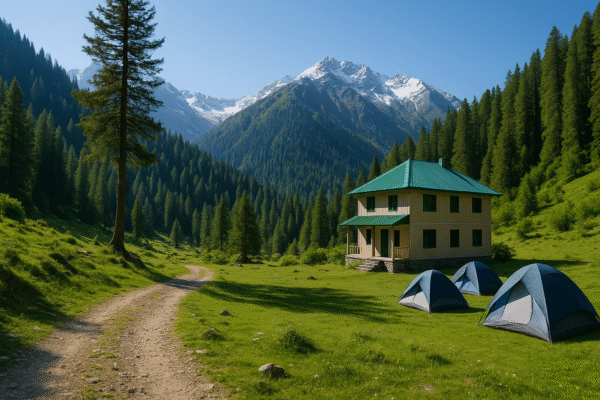Himachal Pradesh is setting a new benchmark in eco-tourism by embracing digital technology, sustainable planning, and grassroots empowerment. With the unveiling of the Eco-Tourism Policy 2024, the picturesque hill state has embarked on a transformative journey—one that promises immersive nature experiences, thriving local economies, and enduring environmental stewardship.
Digital Leap in Booking & Trekking Management
Under the new framework, eco-tourism services such as forest rest houses and camping sites—more than a hundred in total—are now accessible online through the Himachal Pradesh Eco-Tourism Society (HPECOSOC) website. Visitors can seamlessly reserve stays amidst serene forests, previously a cumbersome offline process.
Complementing this, a robust trekking management system catalogues over 245 routes, thoughtfully classified by difficulty. This digital repository will soon be mirrored in a mobile app offering real-time maps, alerts, and navigational guidance—ensuring both adventurous and novice trekkers have safe, informed journeys.
Ambitious Site Development & Tourism Growth
The heart of the policy lies in its ambition to develop 77 eco-tourism sites across the state over the next five years. These sites span key districts including Shimla, Kullu, Mandi, Bilaspur, Rampur, Solan, Nahan, Hamirpur, Nalagarh, Dharamsala, Palampur, Chamba, Dalhousie, Nurpur, and Rekong Peo. Initial implementation has begun at seven high-demand sites: Potter Hill and Shoghi near Shimla; Solang Nallah and Kasol in Kullu’s Parvati Valley. Development will proceed in carefully phased stages to balance infrastructure readiness with ecological sensitivity.
In 2024, the state recorded a visitor surge—more than 18 million tourists, including 82,000 international arrivals—representing a solid 13.24 percent increase year-on-year. Tourism already contributes 7.78 percent to Himachal’s Gross State Domestic Product (GSDP). The government estimates that the eco-tourism expansion will generate approximately ₹200 crore in revenue over five years—fortifying the economy while preserving its verdant charm.
Empowering Local Communities & Conservation
A cornerstone of the policy is community involvement. Eco-tourism committees have been established in every forest circle to oversee implementation and ensure local ownership. Over 70 nature guides and 135 multi-purpose workers have been trained, earning livelihoods while fostering environmental stewardship.
This collective strategy exemplifies the policy’s intention: tourism development that uplifts local communities, safeguards biodiversity, and sustains economic growth.
Integrated Planning & Sustainable Vision
Beyond boosting visitor access, the state harmonizes tourism with conservation. Infrastructure development is being aligned with environmental laws including the amended Forest Conservation Act and guidelines from the Union Ministry of Environment, Forest and Climate Change. The Eco-Tourism Policy 2024 underscores Himachal’s commitment to responsible tourism—integrating mobile tech, controlled site growth, and local stewardship.
Nature’s Wonders & Visitor Experiences
From the lush forests of Solang and Kasol to Shimla’s high slopes, the new eco-tourism framework invites tourists to explore rich biodiversity through activities such as guided jungle walks, birdwatching, forest camping, homestays, and nature interpretation trails. These experiences are further enriched by nearby natural reserves—like the UNESCO-heritage Great Himalayan National Park, offering trekking and wildlife viewing—or serene meadows such as Khajjiar, fondly termed “Mini-Switzerland.”
This synergy of technology, culture, and untouched landscapes positions Himachal as a leading eco-tourism destination—attractive to globetrotters seeking both adventure and conservation.
More Eco-Moves Beyond Tourism
Himachal’s sustainable momentum stretches past this policy. In June 2025, authorities introduced a “Deposit-Refund Scheme 2025” for tourists returning plastic waste—tracked via QR codes—advancing waste management and environmental cleanliness.
Simultaneously, the forest department is steering major eco-centric projects like the Durgesh Aranya Zoological Park in Kangra’s Bankhandi. Targeted for first-phase completion by December 2026, the zoo will feature lion and tiger safaris, eco-tourism circuits, a planetarium, indigenous planting, and 1 MW solar power—earning India’s first IGBC-certified zoological park.
These initiatives reflect the broader “Green Himachal” vision—an integrated push to marry economic growth with ecological responsibility.
Why This Matters for Travelers
For eco-tourists, nature lovers, and responsible travelers, Himachal’s new policy delivers unmatched ease and engagement:
- Accessibility: Book forest stays and trekking trails online.
- Safety & Info: App-guided treks with mapped routes and alerts.
- Inspiration: Fresh eco-destinations offering biodiversity, culture, and solitude.
- Meaning: Travel with purpose—support local jobs, conservation, and green innovation.
As global tourism reckons with sustainability, Himachal Pradesh exemplifies how rooted policy, ecosystem mindfulness, and tech can craft a future where tourism expands, not at nature’s expense, but with it.
For more travel news like this, keep reading Global Travel Wire


















